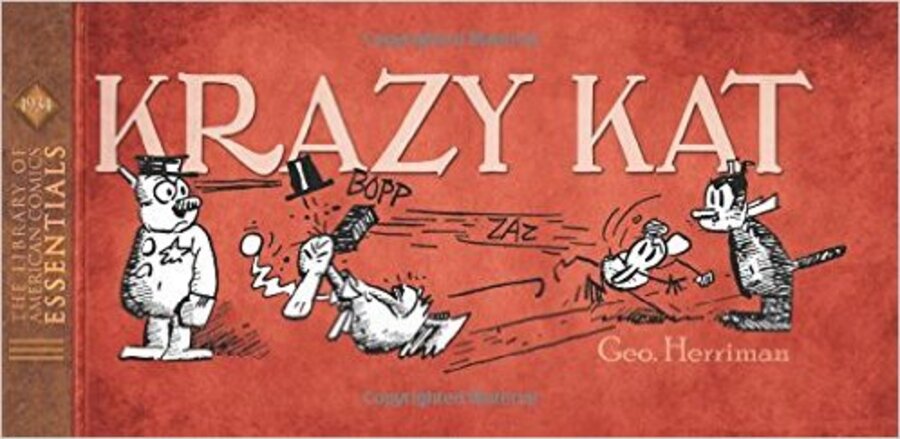'Krazy Kat 1934' is a year's worth of joy
Loading...
A year of George Herriman's classic comic strip is nothing to throw a brick at.
Krazy Kat is considered to be one of the greatest of American comic strips. Because of that, many of the strips have been collected in reprint editions but these have mostly featured Herriman's gorgeous full-page Sunday strips. This new collection, Krazy Kat 1934, put together by The Library of American Comics as part of their "Essentials" series, collects the daily strips from 1934. The book displays a year's worth of the classic comic strip in an oblong shape, 11.5" wide by 4.25" high. One strip is showcased per page, with its original date and strip title to give today's readers a sense of how it was originally viewed in newspapers.
Krazy Kat is a comic strip with a simple premise. Ignatz Mouse cannot help but throw a brick at Krazy Kat's head which tends to get him into trouble with Offissa Pupp. Herriman constantly finds clever ways to play with this scenario as you discover while reading through a year's worth of comics.
The comic takes place in a surreal version of Coconino County, Arizona, with odd-shaped trees and mountains. The three main characters have formed an odd love triangle: Krazy loves Ignatz, calling him "Dolling" and seeing his brick-throwing as affection while Offissa Pupp tries to protect the poor simple-minded Kat with whom he has fallen in love.
Adding to the surrealism of the strip, Krazy's gender tends to flipflop at times. Krazy is sometimes referred to as "he," sometimes as "she." One run of strips in this volume has the town's residents trying to figure out that riddle but to no avail. The "rivals" or Krazy's attention are at constant war, with Ignatz trying to bonk Krazy in head while avoiding detection by Offissa Pupp. Although Ignatz succeeds in hitting his target, the mouse usually ends up tossed in jail.
Krazy Kat himself (or is it herself?) is the source of many gags. Naive, innocent, and happy Krazy wanders through life like a confused child. For many jokes Krazy misunderstands the meaning of a word. For example, in one strip Ignatz is trying to find Timbuctoo in a geography book and Krazy suggests:
"Oh you'll fine where 'Timbugtoo' is in your 'Ridmittic'. Between 'timbug one' an' 'timbug tree'."
Herriman developed an usual dialect for Krazy that added another layer of cleverness to the comic, for example:
"It's so nize of you to karry me ova the rivva, Dolling, us kets is so iffrayed of watta, it's so wed."
In the space of a year's worth of strips, Herriman touches upon a great many subjects from music to sleepwalking and even several strips about "old jokes" making fun of his own overused gag of brick-tossing. The wonderful artistry of Herriman's work in these 1934 strips can be seen in his confident line whether drawing madcap action or moments of reflection. One of the more touted series of strips in this collection is the sweet story of Krazy sitting to watch the last "ottim liff" fall. Years later, Charles Schulz ran a similar series, having Linus watching a stubborn leaf.
Whimsical and surreal, Krazy Kat was not a popular strip with readers when it ran in newspapers from 1913-1944 but thankfully it was loved and championed by publisher William Randolph Hearst who gave Herriman a lifetime contract and complete creative freedom. The comic was popular with intellectuals and art critics, being one of the first comics to be considered "serious" art. And through the years the comic has only grown in popularity.
As with all the volumes of this "Essentials" series, this is a must-have for any fan of the American comic strip. This beautiful volume is a chance to view an iconic American comic strip as closely as possible to the way it was originally presented in 1934. And besides enjoying the art, the gags, and wordplay, you get a window into the mindset of Herriman and the United States at that time. Even the brief but informative introduction by Michael Tisserand is wonderful, jam-packed with some great information on Herriman, Krazy Kat, and the strips collected in this volume. This is a great series that I hope has many more volumes to come.








